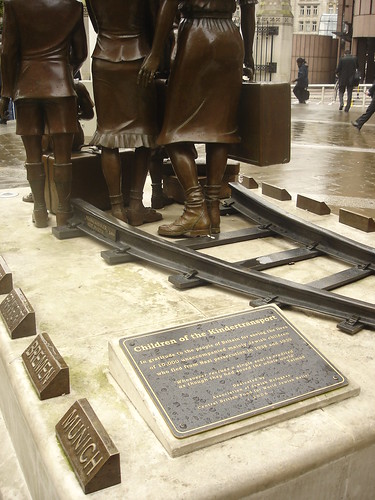
Erika Dreifus / photo credit: Lisa Hancock
In the beginning, I read. I read histories and testimonies. I read Anne Frank’s diary, and “books for children” with titles like Mischling, Second Degree and The Endless Steppe. I read Elie Wiesel. I read Schindler’s List before it became a movie. In college and graduate school, I read more. Much more. I began to notice a shift in authorship. Rather than reading books by those who had lived through Nazi persecution, I was discovering memoirs and fiction by that generation’s children. These were “second-generation” writers, I learned: 2G.
My interest in the subject matter was deeply personal. My father’s parents, German Jews, had immigrated to the United States as young adults—each, alone—in the late 1930s. They met in New York and married in 1941. My father, their only child, was born in 1944. The first of two grandchildren, I arrived in 1969. We were very close. In literal terms, our south Brooklyn apartment was footsteps from theirs; after my parents and sister and I moved to New Jersey in 1978, our visits were frequent and our phone calls even more so.
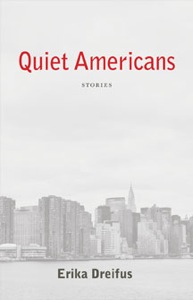 In my twenties, I began writing about this legacy in a few nonfiction pieces. Then I started writing fiction. Increasingly, I found that my fiction was inspired by my grandparents’ refugee experiences and their own family histories. This focus continued after my grandmother’s passing—she was the last surviving grandparent—at the start of my second semester in an MFA program in January 2002. It has resulted in one novel manuscript (unpublished) and one short-story collection, Quiet Americans (published earlier this year).
In my twenties, I began writing about this legacy in a few nonfiction pieces. Then I started writing fiction. Increasingly, I found that my fiction was inspired by my grandparents’ refugee experiences and their own family histories. This focus continued after my grandmother’s passing—she was the last surviving grandparent—at the start of my second semester in an MFA program in January 2002. It has resulted in one novel manuscript (unpublished) and one short-story collection, Quiet Americans (published earlier this year).
But when I began this work, I didn’t know that elsewhere—at other desks, in other countries—other writers were similarly engaged. Also born in or on the edges of the 1970s, these writers, too, have published fictional narratives inspired in some way by their grandparents’ encounters with Nazism, and by their own Holocaust-related family histories of war, immigration, and survival.
Among them are three novelists: Julie Orringer (b. 1973), whose The Invisible Bridge was published in 2010 to considerable acclaim and re-issued in paperback a few months ago; Alison Pick (b. 1975), whose Far to Go, published in the author’s native Canada last fall, has won that country’s Jewish Book Award for fiction and will be released in the U.S. in May 2011; and British writer Natasha Solomons (b. 1980), whose debut novel was published last year in the U.K. as Mr. Rosenblum’s List: Or Friendly Guidance for the Aspiring Englishman and in the U.S. as Mr. Rosenblum Dreams in English.
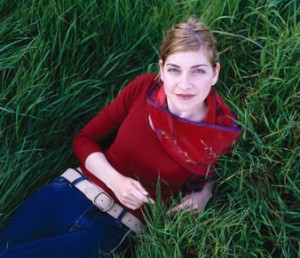
Julie Orringer / photo credit: Stephanie Rausser

Alison Pick
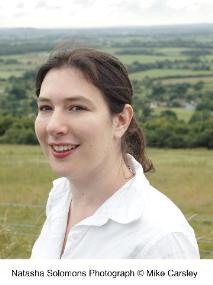
Natasha Solomons / photo credit: Mike Carsley
Whether in front matter, acknowledgments, author bios, or easily-accessed interviews, all three of these writers have spoken openly about their books’ roots in their grandparents’ histories. Moreover, rather than focusing on the sequelae of this family experience on their own lives and psyches—a tendency for which critic Ruth Franklin has sharply (at moments, perhaps too sharply) criticized certain second-generation fiction writers in her important and equally recent book, A Thousand Darknesses: Lies and Truth in Holocaust Fiction—they have spun stories grounded in their grandparents’ prewar and wartime European worlds (and in the case of Mr. Rosenblum, extending into the 1950s).
Reading these novels by Orringer, Pick, and Solomons in the months leading up to and following my own book’s publication, I found an unusual sense of companionship, as an author and as a grandchild.
And as the annual observance of Yom Hashoah (Holocaust Memorial Day) approaches—this year, it will begin at sundown on Sunday, May 1—it seems especially appropriate to recognize these works from an emerging literary cohort.

First, a comment. Some readers—I’ve encountered a few—may believe that, for lack of better phrasing, “too many” “Holocaust stories” are “already” out there. That, again for lack of more felicitous wording, there’s “nothing new” to be gained from work that evokes this cataclysm. To this, I can respond no more eloquently than by quoting Roma Nutkiewicz Ben-Atar, co-author with her son, Doron S. Ben-Atar, of What Time and Sadness Spared: Mother and Son Confront the Holocaust:
The variety of Holocaust experiences is equal to the number of survivors. A terrible common reality engulfed all of us, and yet when I speak to other survivors I sometimes have the distinct impression that each of us, despite having been in the same “there,” has been in a different place. We experienced the horrors as differently as we reacted to the events at the end of the war: the sudden freedom, the liberation we dreamed of, and the return home to find nothing and, most horribly, nearly no one.
Moreover, by shifting the literary terrain away from the by now horrifyingly familiar ghettos, gas chambers, and attics to encompass other stories, including those of people who—like Solomons’ grandparents, or mine— managed to leave their European homelands before World War II’s actual outbreak—we spotlight characters who, as Solomons has so beautifully explained in an interview, lived “on the edges of history,” and their less-recognizable conflicts, plotlines, and settings.
***
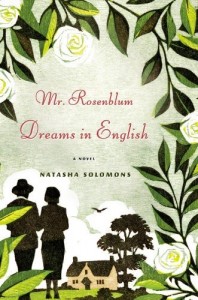 Let us begin with Natasha Solomons’ book, Mr. Rosenblum Dreams in English. As I noted in a review for Jewish Book World last year, the “About the Author” section at the conclusion of this novel states that Mr. Rosenblum “is based on [Solomons’] own grandparents’ experience.” The novel focuses on Jack (né Jakob) Rosenblum, who emigrates from Germany with his wife, Sadie, and their baby daughter in the summer of 1937. Upon arrival, Jack receives a “dusky blue pamphlet entitled While you are in England: Helpful Information and Friendly Guidance for every Refugee.” If Jack cherishes a Bible, this pamphlet is it: “He obeyed the list with more fervour than the most ardent Bar Mitzvah boy did the laws of Kashrut….” Over time, he expands and adds to the list based on his own observations.
Let us begin with Natasha Solomons’ book, Mr. Rosenblum Dreams in English. As I noted in a review for Jewish Book World last year, the “About the Author” section at the conclusion of this novel states that Mr. Rosenblum “is based on [Solomons’] own grandparents’ experience.” The novel focuses on Jack (né Jakob) Rosenblum, who emigrates from Germany with his wife, Sadie, and their baby daughter in the summer of 1937. Upon arrival, Jack receives a “dusky blue pamphlet entitled While you are in England: Helpful Information and Friendly Guidance for every Refugee.” If Jack cherishes a Bible, this pamphlet is it: “He obeyed the list with more fervour than the most ardent Bar Mitzvah boy did the laws of Kashrut….” Over time, he expands and adds to the list based on his own observations.
Sadie Rosenblum does not share her husband’s enthusiasm for throwing off their past (or for his “verdammt list”). She is haunted by the family left behind—and lost—in Germany. This domestic conflict underlies the novel.
But the challenge that actively drives the plot is Jack’s postwar quest to build a golf course in Dorset, which results from his being denied golf-club membership—the final list item, “the quintessential characteristic of the true English gentleman.” In Solomons’ book, then, two specific strands of experience emerge: the immigrant quest to assimilate (in this case, with the immigrant’s Jewishness playing at least as much a role as his Germanness); and a type of “survivor’s guilt” experienced by someone who survived by seeking refuge in another country.
***
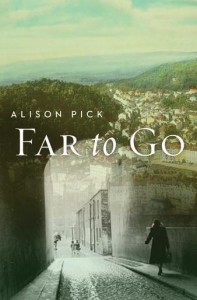 How, when, and where to seek refuge from Nazism are questions at the foundations of the conflicts and tensions in Alison Pick’s Far to Go. Two narratives alternate: one set in the late 1930s and one much more “presentist.” The former narrative dominates, in both page count and power; as at least one reviewer has noted, it is this historical storyline that more compellingly captures the reader’s attention and emotions. (I empathize with the challenge that Pick faced here: One of the repeated responses my then-agent and I received when we circulated my aforementioned novel manuscript was that the book’s “historical” chapters far outshone the ones set closer to the present. In any case, Far to Go’s secondary narrative seems deliberately opaque, evidently a mystery that the reader is intended to comprehend only as the book nears its end.)
How, when, and where to seek refuge from Nazism are questions at the foundations of the conflicts and tensions in Alison Pick’s Far to Go. Two narratives alternate: one set in the late 1930s and one much more “presentist.” The former narrative dominates, in both page count and power; as at least one reviewer has noted, it is this historical storyline that more compellingly captures the reader’s attention and emotions. (I empathize with the challenge that Pick faced here: One of the repeated responses my then-agent and I received when we circulated my aforementioned novel manuscript was that the book’s “historical” chapters far outshone the ones set closer to the present. In any case, Far to Go’s secondary narrative seems deliberately opaque, evidently a mystery that the reader is intended to comprehend only as the book nears its end.)
The main story opens in September 1938, on the eve of the Munich agreement that delivered the Sudetenland to Adolf Hitler. Pavel Bauer is a prosperous factory owner—Jewish—living in a “sleepy Bohemian town” with his wife, Anneliese; their little boy, Pepik; and Pepik’s devoted, non-Jewish governess, Marta. Backgrounded by the steady Nazi takeover of territory from Munich forward, the novel depicts a specific slice of Jewish experience in the Nazi era: in Czechoslovakia, the land that Pick’s paternal grandparents fled in 1941.
Far to Go also spotlights the Kindertransport, by which thousands of Jewish children living in Germany or German-annexed territories (including Czechoslovakia) were able to seek refuge in Great Britain. Reading this novel, one is reminded anew about fiction’s power to illuminate “emotional truths.” One of Pick’s most significant artistic successes is this: It is impossible to absorb scenes at the train station, where little Pepik’s parents and Marta manage to separate themselves from the child, or the subsequent ones in which Pepik finds himself alone on that train and bewildered by what follows once he reaches his destination, without sensing at least a glimmer of the anguish that the actual, nonfictional families must have experienced.
In a radio interview, Pick described her family background. Like Pavel Bauer, Pick’s Czech grandfather owned a factory. But it was another family altogether—that of the factory’s similarly Jewish plant manager—that appears to have supplied the spark for the Kindertransport storyline. (Here, too, I hear echoes of my own fiction-writing experience: the true-life inspiration for my book’s opening story, “For Services Rendered,” came not from the lived experience of my own relatives, but rather from my grandmother’s fairly matter-of-fact mentions of a refugee pediatrician she first encountered when, as a new immigrant in the U.S., she obtained a job as a nanny for a little girl who was this pediatrician’s patient.)
***
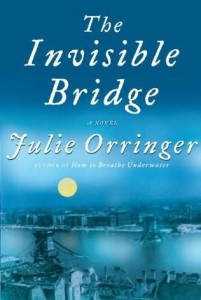 With Julie Orringer’s The Invisible Bridge, we find ourselves again in other settings: the Hungary of the author’s grandparents, and the Paris of the 1930s where both her grandfather and her protagonist, Andras Lévi, went to study architecture. One of the current bugaboos of review-speak is the phrase “pitch-perfect,” but I hold a PhD in Modern French history as well as an MFA in creative writing, and I can assure you that “pitch-perfect” is exactly the right term to describe the 1930s Paris of the first half of Orringer’s novel. As beautiful and romantic as the city remains—Paris is where Andras falls in love with another Hungarian Jewish émigré, Klara, whom he eventually marries—it is nonetheless moving inexorably toward war, with all of the accompanying xenophobia, anti-Semitism, and other ugliness that were indeed part of the true historical picture. In the novel, these forces propel Andras and Klara back to Hungary when Andras’s student visa cannot be renewed in France.
With Julie Orringer’s The Invisible Bridge, we find ourselves again in other settings: the Hungary of the author’s grandparents, and the Paris of the 1930s where both her grandfather and her protagonist, Andras Lévi, went to study architecture. One of the current bugaboos of review-speak is the phrase “pitch-perfect,” but I hold a PhD in Modern French history as well as an MFA in creative writing, and I can assure you that “pitch-perfect” is exactly the right term to describe the 1930s Paris of the first half of Orringer’s novel. As beautiful and romantic as the city remains—Paris is where Andras falls in love with another Hungarian Jewish émigré, Klara, whom he eventually marries—it is nonetheless moving inexorably toward war, with all of the accompanying xenophobia, anti-Semitism, and other ugliness that were indeed part of the true historical picture. In the novel, these forces propel Andras and Klara back to Hungary when Andras’s student visa cannot be renewed in France.
Orringer’s mastery of Paris and French history make me have faith in her subsequent rendering of wartime Hungary, too. And, as Janet Maslin noted in her New York Times review, “‘The Invisible Bridge’ is unusual partly because Hungary was unusual.'” Indeed, deportations of Jews from Hungary to the death camps did not commence until 1944. Which is not to say that life before 1944 for Hungarian Jews like Orringer’s grandparents—or her characters—was easy or secure. Far from it, as the plot of the novel’s second section, which I will not detail here, shows.
I will tell you, however, that throughout both the French and Hungarian portions of the book—which is to say, for the vast majority of my reading time—it seemed as though I were immersed in a classic nineteenth-century realist novel. I am by no means the only reader to have discerned this, and in an excellent interview for the Moment magazine blog, Orringer affirmed that it was at least partially her intent to write exactly that kind of book. But she also wanted to write something “very contemporary.” Toward the book’s end, Orringer does two things to remind us not only of the story’s relevance in the present, but also of her personal connection to the material.
She closes the book with a translation of a poem by Nobelist Wislawa Szymborska. Titled “Any Case,” the poem, in Maslin’s summary, “captures the astonishment felt by descendants, direct or spiritual, of those who survived unspeakable horror.” And even before we reach the poem, Orringer gives us an epilogue in which the close-third point-of-view shifts to a new personage: an unnamed granddaughter of Andras and Klara Lévi. Here, Orringer differs from Solomons and Pick, whose generational characters go no further than those who were young children or born during World War II. (But here, again, some literary kinship: My own collection introduces the third generation’s presence midway through the book. In the fourth story, Quiet Americans has advanced to 1972, and the Jewish refugee couple featured in the preceding story have become grandparents. It is not until the penultimate story, set in 2004, that an adult grandchild—also unnamed—takes narrative center stage.)In her epilogue, Orringer writes of the Lévis’ granddaughter: “She’d learned about that war in school, of course—who had died, who killed whom, how, and why—though her books hadn’t had much to say about Hungary. She’d learned other things about the war from watching her grandmother, who saved plastic bags and glass jars, and kept bottles of water in the house in case of disaster, and made layer cakes with half as much butter and sugar as the recipes called for, and who, at times, would begin to cry for no reason.” And: “There were strands of darker stories. She didn’t know how she’d heard them; she thought she must have absorbed them through her skin, like medicine or poison. Something about labor camps. Something about being made to eat newspapers. Something about a disease that came from lice. Even when she wasn’t thinking about those half stories, they did their work in her mind.”
Indeed they did. I’ll go so far as to suggest that for all of us, even two generations later, in the United States or Canada or Great Britain or wherever our grandparents were able to raise our parents and, eventually, watch us grow up, the stories—fragmented or not—have done their work in our minds. If they hadn’t, it’s unlikely that these books would have been written.
Further Links and Resources
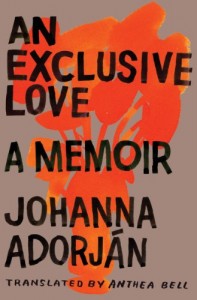 By age and family history, if not by genre, this literary cohort also includes Johanna Adorján (b. 1971). Adorján’s book, An Exclusive Love (trans. Anthea Bell), was published in Germany in 2009 and released in an English edition in the U.S. earlier this year. Technically, An Exclusive Love is a memoir. It focuses on Adorján’s paternal grandparents, Hungarian Jews who survived the Holocaust, fled Budapest during the 1956 uprising there, and rebuilt their lives in Denmark. This is all important and essential background, and Adorján is careful to delineate what she knows about it and what she has been unable to find out. But the book’s driving force is Adorján’s effort to reconstruct a single day in her grandparents’ lives: October 13, 1991, the day they committed suicide together. In the very best sense, An Exclusive Love is a memoir that reads like a novel, combining the strengths of both literary worlds and, importantly, remaining steadfastly honest about what “really happened” and what can only be envisaged.
By age and family history, if not by genre, this literary cohort also includes Johanna Adorján (b. 1971). Adorján’s book, An Exclusive Love (trans. Anthea Bell), was published in Germany in 2009 and released in an English edition in the U.S. earlier this year. Technically, An Exclusive Love is a memoir. It focuses on Adorján’s paternal grandparents, Hungarian Jews who survived the Holocaust, fled Budapest during the 1956 uprising there, and rebuilt their lives in Denmark. This is all important and essential background, and Adorján is careful to delineate what she knows about it and what she has been unable to find out. But the book’s driving force is Adorján’s effort to reconstruct a single day in her grandparents’ lives: October 13, 1991, the day they committed suicide together. In the very best sense, An Exclusive Love is a memoir that reads like a novel, combining the strengths of both literary worlds and, importantly, remaining steadfastly honest about what “really happened” and what can only be envisaged. Other relatively recent books of fiction that I’ve found striking at least in part for the authors’ inclusion of “grandparent” characters with origins in Nazi Europe include Our Holocaust, by Israeli author Amir Gutfreund (trans. Jessica Cohen), and The Pale of Settlement, a collection of linked stories by Margot Singer that won the Flannery O’Connor Award for Short Fiction, the Glasgow Prize for Emerging Writers, and the Reform Judaism Prize for Jewish Fiction. For a brief summary of the former, which won Israel’s Sapir Prize, see its Kirkus review, which also alludes to the book’s autobiographical/familial elements. For interviews with Margot Singer about the latter, including discussions of the relevance of her own grandparents’ histories, see Reform Judaism magazine and Southeast Review Online. (See also my review for Kenyon Review Online.)
Other relatively recent books of fiction that I’ve found striking at least in part for the authors’ inclusion of “grandparent” characters with origins in Nazi Europe include Our Holocaust, by Israeli author Amir Gutfreund (trans. Jessica Cohen), and The Pale of Settlement, a collection of linked stories by Margot Singer that won the Flannery O’Connor Award for Short Fiction, the Glasgow Prize for Emerging Writers, and the Reform Judaism Prize for Jewish Fiction. For a brief summary of the former, which won Israel’s Sapir Prize, see its Kirkus review, which also alludes to the book’s autobiographical/familial elements. For interviews with Margot Singer about the latter, including discussions of the relevance of her own grandparents’ histories, see Reform Judaism magazine and Southeast Review Online. (See also my review for Kenyon Review Online.)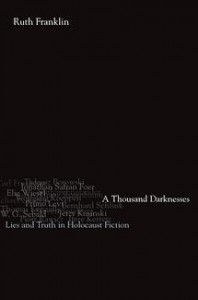 Ruth Franklin’s above-mentioned A Thousand Darknesses in fact concludes with a section on “The Third Generation” (available in part via Google books). Franklin does not delve into the family histories of the authors she cites as belonging to this cohort. (Did Michael Chabon’s grandparents come from Nazi-dominated Europe? For Franklin, the question is quite possibly irrelevant.) But simply by training her expert critical eye on fiction that she characterizes as “third-generation,” Franklin advances the discussion significantly. She hesitates, she says, to call writers of this cohort “‘Holocaust writers,’ because although their works do touch on the subject, tangentially or more directly, it is never their main focus. Indeed, this is part of their literary liberation.” In addition to Chabon, her exemplars include Nathan Englander and Jonathan Safran Foer. She focuses on the ways in which these writers “have turned Jewish literary tradition inside out” and in particular, their use of fantasy.
Ruth Franklin’s above-mentioned A Thousand Darknesses in fact concludes with a section on “The Third Generation” (available in part via Google books). Franklin does not delve into the family histories of the authors she cites as belonging to this cohort. (Did Michael Chabon’s grandparents come from Nazi-dominated Europe? For Franklin, the question is quite possibly irrelevant.) But simply by training her expert critical eye on fiction that she characterizes as “third-generation,” Franklin advances the discussion significantly. She hesitates, she says, to call writers of this cohort “‘Holocaust writers,’ because although their works do touch on the subject, tangentially or more directly, it is never their main focus. Indeed, this is part of their literary liberation.” In addition to Chabon, her exemplars include Nathan Englander and Jonathan Safran Foer. She focuses on the ways in which these writers “have turned Jewish literary tradition inside out” and in particular, their use of fantasy.

